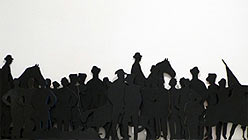“The study of history may be a search for clarity, but in the end what we have is less of a tidy explanation than a melee of names, dates, and costumes, with some blood splashed around for effect.” So writes Bean Gilsdorf in the text that accompanies her one-woman show at Mission: Comics and Art. The Last Charge rushes towards us with all of these tensions intact, precise and clear in craft and intention, but full of details that mask and complicate each other.
One of Gilsdorf’s many strengths is her melding of form and content. She typically appropriates her imagery; most of the work for The Last Charge consists of collaged, mass-market Civil War images printed digitally onto linen, a technical choice that echoes her concern about the glut of historical detail and our desire to freeze it in narrative form. Even when she works sculpturally, she maintains the tension. Untitled, the one piece of sculpture in the show, consists of a shelf of black, masonite silhouettes with brightly-painted edges to keep them distinct from each other. Viewed at varying distances, the silhouettes merge into one solid “image” and then fall apart again.

Gilsdorf also works large, so that the viewer becomes immersed in her works, amplifying their emotional resonance. In Ruin, for example, we come face to face with a black-and-white image of a soldier, printed on linen over a painterly swath of gold acrylic. At 44″ tall, the work disturbs because you’re meant to meet the soldier’s gaze, and yet where the face should be, the fabric is threadbare — the face reduced to a ghost-image.




